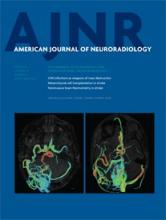We would like to thank Benson et al for their thoughtful reading of our recent work and their comments. We do agree with them that there is no evidence demonstrating the inferiority of proximal occlusion versus trapped occlusion of large or giant carotid aneurysms because there is no controlled study in the literature. Our 2 “controversial statements” certainly have to be nuanced because they reflect personal considerations based on our own (unpublished) practical experience of proximal occlusion.
The comparison between the series of Drake et al1 and ours2 has several limitations. If we consider this exploratory comparison, we observed similar rates of complete aneurysmal occlusion (99% versus 97% for cavernous and 74% versus 73% for ophthalmic aneurysms, respectively). However, in the series of Drake et al, an additional trapping was performed in 5% of patients with carotid cavernous aneurysms and in 21.7% of patients with ophthalmic aneurysms. The comparison of the severe morbidity rate is uncertain because the available outcome criteria are different in the series of Drake et al and ours. This rate may be 1.3% versus 2.5% (or 0% if we consider only patients with a modified Rankin Scale score of >2) for cavernous and 8.6% versus 14.3% (7% if we consider only patients with a modified Rankin Scale score of >2) for ophthalmic aneurysms, respectively. In the series of Drake et al, the mortality rate seems to be higher because we observed no death in our series. In the same series of Drake et al, the severe morbidity and mortality rates were equal to zero for both carotid cavernous and ophthalmic aneurysms if we consider only the proximal occlusions performed with detached balloons (including 19/63 [30%] extra-/intracranial bypasses).
We do not share the assumption of Benson et al that, “The addition of distal occlusion may have contributed to … the increased rate of ischemic events in 27% of patients [of our series], because the origins of perforating vessels will by definition be occluded across any trapped segment.” Actually, in our series, no perforating vessel was occluded with coils and no ischemic event was attributed to this mechanism because, “When the upstream segment was too short to set up coils, an occlusion of the aneurysm and of the parent artery was performed in opposition and downstream.”2 Therefore, we do not think that this trapping technique presents a higher risk of adverse events compared with proximal occlusion alone. On the contrary, we consider that the trapping technique may have 2 potential (albeit unproven) benefits compared with the proximal occlusion alone, especially in carotid ophthalmic giant aneurysms. These potential benefits are the following:
To prevent a massive embolism coming from the occluded segment by trapping the thrombus (2.5%/0% of the carotid cavernous/ophthalmic aneurysms in the series of Drake et al1 versus none in our series).
To prevent the risk of bleeding of the untrapped aneurysm until it is completely excluded from the arterial flow (no patients in the series of Drake et al1 but several cases are reported in the literature3).
In conclusion, despite our personal preferences for proximal occlusion versus trapped occlusion, we can only share the opinion of Benson et al that “proximal—as well as trapped—occlusion of the parent artery without trapping remains a viable time-honored treatment option for giant saccular and fusiform carotid aneurysms.”
References
- © 2015 by American Journal of Neuroradiology












